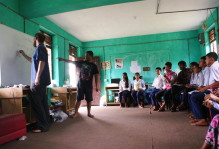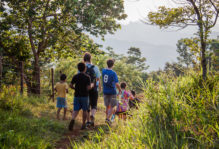Progress in Chaguite?
Chaguite, Nicaragua, March 8, 2015. Today is the opening community meeting for this year’s project trip. The meeting is scheduled for 2pm. Dr. Kenneth Lamb, Assistant Professor of Engineering at California State Polytechnic University, Pomona and lead engineer for the Engineers Without Borders (EWB) team with whom we are partnering, makes a short presentation to say that EWB will need to collect more data and conduct more analyses before any proposals can be made for improving access to clean water for households in the community.
Johnathan Maza ’15 and Quetzabel (“Q”) Benavides ’16 make a scoop for sagging morale by suggesting that there are other, small projects that need to be done in anticipation of the engineering solution. When finished, the water access solution likely will not deliver treated water. Water will need to be treated and stored safely for household use. Perhaps we can work on a smaller project that we can complete in one year and using only resources controlled by residents and MANOS?
A very senior resident begins the community response by noting how long we’ve been coming to the community, how many questions we’ve asked over the years, and how little result can be seen. He gives credit for some tiny progress, but he wonders how long it must take for our partnership to produce real change — access to clean water that is needed desperately. He is right, of course, and yet not quite. His story neglects important details and simplifies great complexities. It is nonetheless true to him — and to some others in the room and the community.
Progress in solving basic problems of water access has been very slow. Since coming to Chaguite seven years ago, we have watched as a project was organized by the mayor’s office and funded by the Japanese government. The project moved quickly and produced a deep-water well that serves about 20% of the households in the community. During the unfolding of the project, we listened to residents complain that the well should not be built but rather those funds should be used for a project that could serve more — perhaps most — households. The well was built, sited in a location that allowed access to deep water but also that limited access for all but a handful of the households.
Over the same period of time, we were drawn into a collaboration with engineers from universities in Managua. We shared a description of our mission, methods, five-year plan, and some data and these engineers used the information to win a European Union grant to build some cisterns in the community. The engineers felt compelled by the grant funds to move quickly and they implemented a strategy that relied heavily on convenience: those deemed “ready” to benefit from the kind of cistern that the engineers wanted to build would be selected to participate. Those who were not “ready” (i.e., did not have zinc roofs needed to support rainwater collection) simply were left out. The engineers seemed surprised by the low level of community investment in the project and by the conflict that developed during implementation. The cisterns that were built are too small to serve any useful purpose (that is, they provide water for only a small portion of the extended dry period) and some of the cisterns are already non-functional. The engineers explain that some of the materials needed for cistern construction were misappropriated and cistern quality was undermined. From a sociological perspective, this sounds very much like blaming the victim.
And so a fuller rendering of the “progress” narrative would confirm the limited progress but might note persistence and perseverance grounded in basic convictions about the importance of authentic partnerships that keep community residents in the lead in deciding on strategies and in organizing to manage and implement strategies that make sense relative to local realities.
From the beginning, we have embraced the idea of development as agency: learning to do with our partners rather than doing for them. Through our partnering efforts, we have identified organic networks of communications and collaboration and we have encouraged residents to build on these to tap the fuller potential that comes from working together to find, implement, and own solutions to collective problems. This approach requires promoting inclusive discussions and conclusions — and it takes time. It has produced a community-endorsed five-year health plan, a proposal to EWB that has been adopted by Cal Poly Pomona, and an elected committee to guide water-access projects. And this version of the story is true also — and not quite complete.



No comments.
Comments are currently closed. Comments are closed on all posts older than one year, and for those in our archive.